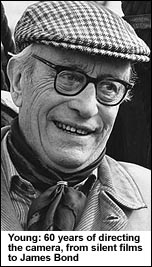|
Daily Telegraph (UK)
|
|
Issue 1289
|
Saturday 5 December 1998
|
Freddie Young
 Cinematographer who won three Oscars and provided David Lean with grand
panoramas for Lawrence of Arabia and Doctor Zhivago
Cinematographer who won three Oscars and provided David Lean with grand
panoramas for Lawrence of Arabia and Doctor Zhivago
Each was remarkable for the beauty of its images, and for each Young won
an Oscar.
Although Young was thought of as having a preference for film on the grand
scale and was always happiest shooting outdoors, in truth his photography
had no marked style and was free of mannerisms. If his films had a common
characteristic it was his professionalism, which ensured he reflected only
the director's vision.
The director with whom he was most closely associated was David Lean, in
partnership with whom Young won all his Oscars. Their relationship was fruitful
but complex. "I got on very well with David," recalled Young recently, "but
he was inclined to take the credit for everything. Oh, he'd pat me on the
back, give me a hug, but he seldom divulged my contributions to the world."
Nevertheless, Young's artistry was apparent to anyone who saw his work,
perhaps most notably in Lawrence of Arabia (1962), which contains one of
the greatest shots in cinema, that in which Peter O'Toole and his guide
gaze at a figure slowly emerging from the heat haze of the desert. The shot
lasts for three minutes. Young got it in one take.
Frederick Archibald Young was born in London in October 1902. As a boy he
was a useful footballer and boxer and adored the silent films of the day.
He experimented with a Box Brownie and at 15 got a job as a teaboy at Gaumont
Studios in Shepherd's Bush. He was soon promoted to laboratory assistant.
Before the Great War, film-making was still a primitive art. "The studios
were in a glasshouse to get the light," recalled Young. "If a cloud came
over the sun, the set would go very dark. It was very crude. We had a few
arc lights, but it was what I'd call illumination, not lighting." In 1918
Young developed and hand-printed all 6,000 ft of The Man in the Moon, the
first British science fiction film.
By the time sound came to the cinema in 1927, Young had already become an
outstanding lighting cameraman and had photographed his first film, The
Flag Lieutenant (1926). Impressed by this, in 1929 the producer Herbert
Wilcox took him under contract to MGM, where his jobs included everything
from editing to driving the studio car.
In 1932, Wilcox gave him The Blue Danube to shoot and, after it proved a
success, Young photographed a number of the costume dramas in which Anna
Neagle - Wilcox's wife - provided impersonations of celebrated women, among
them Nell Gwynn (1934) and Victoria the Great (1937). Young was also chief
cameraman on No?l Coward's Bitter Sweet (1933) and Goodbye Mr Chips (1939),
with Robert Donat.
When, at the start of the Second World War, RKO invited Wilcox and Anna
Neagle to Hollywood to make Nurse Edith Cavell, Young went with them. Being
accustomed to organising every detail of the cinematography himself, he
found the American way of working - where gaffers and focus-pullers expected
a measure of independence - not to his liking, and he soon returned
to England to work for the Army Film Unit.
There he made numerous Army training films, and for Michael Powell photographed
49th Parallel (1941) and for Carol Reed the patriotic The Young Mr Pitt
(1942).
After the war, Young was able to slip the shackles of MGM and realised his
ambition of becoming a freelance director of photography. Colour had arrived
and many of the films he now worked on were the large Anglo-American co-productions
which characterised the Age of Cinemascope. Among his credits was Caesar
and Cleopatra (1949), written by Bernard Shaw and at the time the most expensive
British film.
Its director, Gabriel Pascal, imported sand to Egypt, where the film was
shot, because he did not like the colour of the local stuff. The film itself
was dull, but there was ample compensation in Young's lush photography.
Other films of the time were The Winslow Boy (1948), Ivanhoe (1952) for
which he was nominated for an Oscar, and Knights of the Round Table (1954).
He also devised the vivid palette for the Van Gogh biopic Lust for Life
(1956), with Kirk Douglas, and photographed The Inn of the Sixth Happiness
(1958).
Young continued to work throughout the 1960s and 1970s on such films as
the James Bond picture You Only Live Twice (1967) and the story of the last
Tsar, Nicholas and Alexandra (1970), for which he was nominated for an Oscar.
He won an Emmy for a television version of Macbeth.
Young was a perfectionist and his example is largely responsible for the
high technical standards in British film-making. Among those he encouraged
and trained were the cinematographers Freddie Francis, Jack Cardiff and
Nic Roeg.
His skill as a director of photography probably deprived him of the chance
to direct films himself, although at the age of 82 he did make a television
film, Arthur's Hallowed Ground. He himself had mixed feelings about directors:
"Those limelight hogs think they're God. Vincente Minelli interfered with
everything. George Cukor talked for hours to the actors. But nice chaps.
Gentlemen."
Freddie Young was appointed OBE in 1970.
He married first, in 1927, Marjorie Gaffney; they had a son and a daughter.
She died in 1963. The next year he married Joan Morduch, who survives him;
they had a son.
Back to index


 Cinematographer who won three Oscars and provided David Lean with grand
panoramas for Lawrence of Arabia and Doctor Zhivago
Cinematographer who won three Oscars and provided David Lean with grand
panoramas for Lawrence of Arabia and Doctor Zhivago